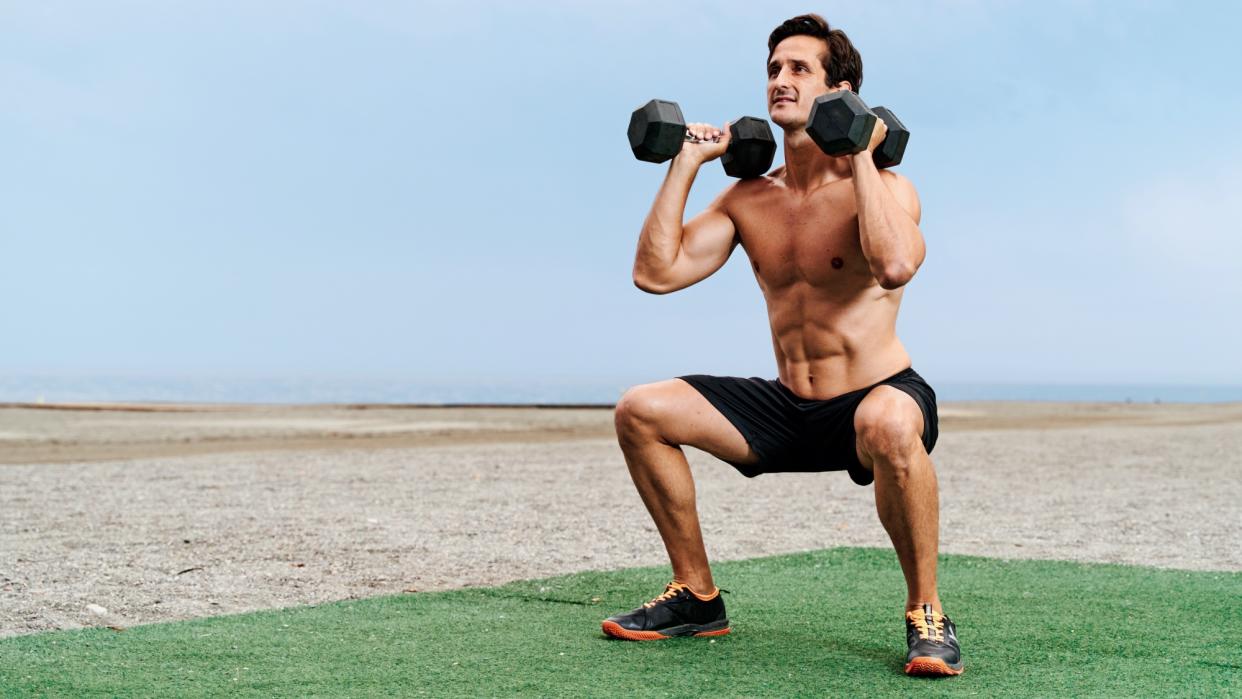I teach weightlifting for a living — this compound exercise builds full-body strength with dumbbells

Ramp up your heart rate, build a stronger core and target your whole body using the dumbbell squat clean. Single or dual load, but prepare to put nearly every muscle group through the wringer.
The move combines a clean and front squat and crops up in CrossFit workouts and powerlifting classes all the time using barbells. But free weights are the more accessible option if you enjoy home workouts, and investing in a set of the best adjustable dumbbells will provide you with the versatility to build stronger muscles and improve your cardiovascular system wherever you train.
To help you get started with this full-body exercise, we'll cover how to do dumbbell squat cleans with proper form, mistakes to watch out for and the benefits.
How to do the dumbbell squat clean
Stand with your feet hip or shoulder-width apart and hold a dumbbell in each hand
Brace your stomach to protect your lower back and pre-tension your glutes, shoulders and hips
Squat down, send your hips back and keep your heels planted down, chest lifted and shoulders set back and down. Look ahead
Touch one head of each dumbbell to the floor outside of your feet
Maintain a flat back without hunching or rounding through your spine and ensure your shoulders are over the bells
Explosively drive the dumbbells up to your shoulders into the front rack position, lifting your elbows slightly as you land the weights. As your dumbbells reach mid-thigh, snappily extend your hips and knees as you stand and pull your body under the dumbbells, catching them in the squat position
Pause at the bottom of the squat, keeping your weight distributed through your feet
Drive up to stand while keeping the dumbbells racked at your shoulders
Repeat for reps and sets
Once you feel comfortable with the mechanics of the move, focus on shrugging your shoulders during the clean phase (driving the weights from floor to shoulders) and allow your heels to leave the ground briefly, then catching the weights in the full squat position with heels planted. Avoid pausing between clean and squat.
Benefits of the squat clean
The Olympic weightlifting exercise is a compound exercise that targets the upper and lower body. It’s an explosive lift, but unlike the power clean, you’ll perform a full squat with the weight racked at your shoulders.
We’re going to focus on the dumbbell squat clean, which acts as a great gateway exercise for beginners to learn the movement pattern before learning how to use barbells. The barbell squat clean often crops up during CrossFit workouts, powerlifting competitions and weightlifting classes as the more advanced variation.
Squat cleans target so many more muscle groups than you'd imagine, including your core muscles, which support safe and powerful movement, the glutes, quads, hamstrings, calves, mid and upper trapezius (muscles in your back), anterior and lateral deltoids (shoulders) and the biceps.
It’s all about a transfer of explosive power. Although the lower body is dominant during all phases of the movement, the upper body assists in driving the weights upward to your shoulders and stabilizing the weights during the squat.
You’ll learn to coordinate the upper and lower body as you transfer force from the legs, hips and glutes to the upper body and extend through the knees and hips. Your core muscles help stabilize the trunk as you lift, so although the squat clean is a full-body exercise, your core muscles are key drivers. The aim is to avoid pulling all the weight with your arms or allowing the weights to travel too far from the body.
Your power comes from the legs and core. If your goal is to build power and strength or improve functional fitness, the squat clean is a brilliant exercise to consider adding to your programs and if you want to learn to lift heavier weights, the barbell is endlessly loadable.
Learning these skills transfers to daily activities and other sports, especially ones that involve explosive speed (like sprinting) or heavy lifting, and other compound exercises, such as front squats and deadlifts.
How to program squat cleans
Always use a weight that allows you to exercise full control over each phase of the movement so you can drill down on your mechanics early on before bad habits creep in; to do this, you’ll need to lift a light enough weight, especially at first.
If you plan to learn Olympic lifting and hone your technique on moves like clean and jerks and snatches, the squat clean should absolutely be one to add to your programs.
If you’re loading heavy, program your squat cleans early on in the workout as the main component before neuromuscular fatigue sets in. We cover hypertrophy versus strength training in more detail to help you program for each.
But as a general rule of thumb, aim for somewhere between 4-6 sets of 1-5 reps and rest for a few minutes between sets. For endurance-focused workouts or metabolic conditioning sessions, you can go lighter and focus on higher reps.
If you have a pre-existing injury or health condition or are returning to exercise following pregnancy, we recommend consulting a qualified medical professional before starting a new exercise program. Modify to your ability and stop if you experience pain.
